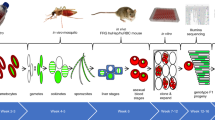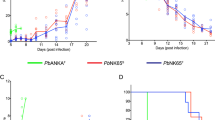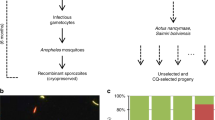Abstract
Resistance to blood-stage malaria in AcB55 and AcB61 is caused by a loss of function mutation in pyruvate kinase (PklrI90N). Likewise, pyruvate kinase (PK) deficiency in humans is protective against Plasmodium replication in vitro. We identified a third AcB strain, AcB62 that also carries the PklrI90N mutation. However, AcB62 mice were susceptible to P.chabaudi infection and showed high levels of parasite replication (54–62% peak parasitemia). AcB62 mice showed the hallmarks of PK deficiency-associated anemia similar to AcB55/61 with reticulocytosis, splenic red pulp expansion, tissue iron overload, and increased expression of iron metabolism proteins. This suggests that malaria susceptibility in AcB62 is not because of absence of PK deficiency-associated pathophysiology. To map novel genetic factors affecting malaria susceptibility in AcB62, we generated an informative F2 population using AcB62 (PklrI90N) and CBA-Pkslc (PklrG338D) as progenitors and identified a novel locus on chromosome 9 (Char10; LOD=7.24) that controls peak parasitemia. A weaker linkage to the Pklr region of chromosome 3 (LOD=3.7) was also detected, a finding that may reflect the segregation of the two defective Pklr alleles. AcB62 alleles at both loci are associated with higher peak parasitemia. These results identify Char10 as a novel locus modulating severity of malaria in the context of PK deficiency.
This is a preview of subscription content, access via your institution
Access options
Subscribe to this journal
Receive 6 digital issues and online access to articles
$119.00 per year
only $19.83 per issue
Buy this article
- Purchase on Springer Link
- Instant access to full article PDF
Prices may be subject to local taxes which are calculated during checkout






Similar content being viewed by others
References
Mackinnon MJ, Mwangi TW, Snow RW, Marsh K, Williams TN . Heritability of malaria in Africa. PLoS Med 2005; 2: e340.
Fortin A, Stevenson MM, Gros P . Susceptibility to malaria as a complex trait: big pressure from a tiny creature. Hum Mol Genet 2002; 11: 2469–2478.
Kwiatkowski DP . How malaria has affected the human genome and what human genetics can teach us about malaria. Am J Hum Genet 2005; 77: 171–192.
Williams TN . Human red blood cell polymorphisms and malaria. Curr Opin Microbiol 2006; 9: 388–394.
Min-Oo G, Gros P . Erythrocyte variants and the nature of their malaria protective effect. Cell Microbiol 2005; 7: 753–763.
Kwiatkowski D . Genetic susceptibility to malaria getting complex. Curr Opin Genet Dev 2000; 10: 320–324.
Fortin A, Stevenson MM, Gros P . Complex genetic control of susceptibility to malaria in mice. Genes Immun 2002; 3: 177–186.
Hernandez-Valladares M, Naessens J, Iraqi FA . Genetic resistance to malaria in mouse models. Trends Parasitol 2005; 21: 352–355.
Fortin A, Diez E, Rochefort D, Laroche L, Malo D, Rouleau GA et al. Recombinant congenic strains derived from A/J and C57BL/6J: a tool for genetic dissection of complex traits. Genomics 2001; 74: 21–35.
Min-Oo G, Fortin A, Pitari G, Tam M, Stevenson MM, Gros P . Complex genetic control of susceptibility to malaria: positional cloning of the Char9 locus. J Exp Med 2007; 204: 511–524.
Min-Oo G, Fortin A, Tam MF, Gros P, Stevenson MM . Phenotypic expression of pyruvate kinase deficiency and protection against malaria in a mouse model. Genes Immun 2004; 5: 168–175.
Fortin A, Cardon LR, Tam M, Skamene E, Stevenson MM, Gros P . Identification of a new malaria susceptibility locus (Char4) in recombinant congenic strains of mice. Proc Natl Acad Sci USA 2001; 98: 10793–10798.
Min-Oo G, Fortin A, Tam MF, Nantel A, Stevenson MM, Gros P . Pyruvate kinase deficiency in mice protects against malaria. Nat Genet 2003; 35: 357–362.
Zanella A, Bianchi P . Red cell pyruvate kinase deficiency: from genetics to clinical manifestations. Baillieres Best Pract Res Clin Haematol 2000; 13: 57–81.
Kanno H, Morimoto M, Fujii H, Tsujimura T, Asai H, Noguchi T et al. Primary structure of murine red blood cell-type pyruvate kinase (PK) and molecular characterization of PK deficiency identified in the CBA strain. Blood 1995; 86: 3205–3210.
Min-Oo G, Tam M, Stevenson MM, Gros P . Pyruvate kinase deficiency: correlation between enzyme activity, extent of hemolytic anemia and protection against malaria in independent mouse mutants. Blood Cells Mol Dis 2007; 39: 63–69.
Ayi K, Min-Oo G, Serghides L, Crockett M, Kirby-Allen M, Quirt I et al. Pyruvate kinase deficiency and malaria. N Engl J Med 2008; 358: 1805–1810.
Demant P, Hart AA . Recombinant congenic strains—a new tool for analyzing genetic traits determined by more than one gene. Immunogenetics 1986; 24: 416–422.
Thawani N, Tam M, Stevenson MM . STAT6-mediated suppression of erythropoiesis in an experimental model of malarial anemia. Haematologica 2009; 94: 195–204.
Roy MF, Riendeau N, Bedard C, Helie P, Min-Oo G, Turcotte K et al. Pyruvate kinase deficiency confers susceptibility to Salmonella typhimurium infection in mice. J Exp Med 2007; 204: 2949–2961.
Canonne-Hergaux F, Donovan A, Delaby C, Wang HJ, Gros P . Comparative studies of duodenal and macrophage ferroportin proteins. Am J Physiol Gastrointest Liver Physiol 2006; 290: G156–G163.
Delaby C, Pilard N, Puy H, Canonne-Hergaux F . Sequential regulation of ferroportin expression after erythrophagocytosis in murine macrophages: early mRNA induction by haem, followed by iron-dependent protein expression. Biochem J 2008; 411: 123–131.
Gruenheid S, Canonne-Hergaux F, Gauthier S, Hackam DJ, Grinstein S, Gros P . The iron transport protein NRAMP2 is an integral membrane glycoprotein that colocalizes with transferrin in recycling endosomes. J Exp Med 1999; 189: 831–841.
Canonne-Hergaux F, Gruenheid S, Ponka P, Gros P . Cellular and subcellular localization of the Nramp2 iron transporter in the intestinal brush border and regulation by dietary iron. Blood 1999; 93: 4406–4417.
Haley CS, Knott SA . A simple regression method for mapping quantitative trait loci in line crosses using flanking markers. Heredity 1992; 69: 315–324.
Lander ES, Botstein D . Mapping mendelian factors underlying quantitative traits using RFLP linkage maps. Genetics 1989; 121: 185–199.
Broman KW, Wu H, Sen S, Churchill GA . R/qtl: QTL mapping in experimental crosses. Bioinformatics 2003; 19: 889–890.
Stevenson MM, Lyanga JJ, Skamene E . Murine malaria: genetic control of resistance to Plasmodium chabaudi. Infect Immun 1982; 38: 80–88.
Wunderlich F, Mossmann H, Helwig M, Schillinger G . Resistance to Plasmodium chabaudi in B10 mice: influence of the H-2 complex and testosterone. Infect Immun 1988; 56: 2400–2406.
Krucken J, Dkhil MA, Braun JV, Schroetel RM, El-Khadragy M, Carmeliet P et al. Testosterone suppresses protective responses of the liver to blood-stage malaria. Infect Immun 2005; 73: 436–443.
Wunderlich F, Marinovski P, Benten WP, Schmitt-Wrede HP, Mossmann H . Testosterone and other gonadal factor(s) restrict the efficacy of genes controlling resistance to Plasmodium chabaudi malaria. Parasite Immunol 1991; 13: 357–367.
Andrews NC . Forging a field: the golden age of iron biology. Blood 2008; 112: 219–230.
Schaible UE, Kaufmann SH . Iron and microbial infection. Nat Rev 2004; 2: 946–953.
Canonne-Hergaux F, Zhang AS, Ponka P, Gros P . Characterization of the iron transporter DMT1 (NRAMP2/DCT1) in red blood cells of normal and anemic mk/mk mice. Blood 2001; 98: 3823–3830.
Horton MA . Expression of transferrin receptors during erythroid maturation. Exp Cell Res 1983; 144: 361–366.
Foote SJ, Burt RA, Baldwin TM, Presente A, Roberts AW, Laural YL et al. Mouse loci for malaria-induced mortality and the control of parasitaemia. Nat Genet 1997; 17: 380–381.
Ohno T, Ishih A, Kohara Y, Yonekawa H, Terada M, Nishimura M . Chromosomal mapping of the host resistance locus to rodent malaria (Plasmodium yoelii) infection in mice. Immunogenetics 2001; 53: 736–740.
Malaguarnera L, Musumeci S . The immune response to Plasmodium falciparum malaria. Lancet Infect Dis 2002; 2: 472–478.
Stevenson MM, Riley EM . Innate immunity to malaria. Nat Rev Immunol 2004; 4: 169–180.
Schofield L, Grau GE . Immunological processes in malaria pathogenesis. Nat Rev Immunol 2005; 5: 722–735.
Ing R, Stevenson MM . Dendritic cell and NK cell reciprocal cross talk promotes gamma interferon-dependent immunity to blood-stage Plasmodium chabaudi AS infection in mice. Infect Immun 2009; 77: 770–782.
Kim CC, Parikh S, Sun JC, Myrick A, Lanier LL, Rosenthal PJ et al. Experimental malaria infection triggers early expansion of natural killer cells. Infect Immun 2008; 76: 5873–5882.
van der Heyde HC, Pepper B, Batchelder J, Cigel F, Weidanz WP . The time course of selected malarial infections in cytokine-deficient mice. Exp Parasitol 1997; 85: 206–213.
Su Z, Stevenson MM . Central role of endogenous gamma interferon in protective immunity against blood-stage Plasmodium chabaudi AS infection. Infect Immun 2000; 68: 4399–4406.
Turcotte K, Gauthier S, Malo D, Tam M, Stevenson MM, Gros P . Icsbp1/IRF-8 is required for innate and adaptive immune responses against intracellular pathogens. J Immunol 2007; 179: 2467–2476.
Su Z, Stevenson MM . IL-12 is required for antibody-mediated protective immunity against blood-stage Plasmodium chabaudi AS malaria infection in mice. J Immunol 2002; 168: 1348–1355.
Tian L, Wu X, Chi C, Han M, Xu T, Zhuang Y . ADAM10 is essential for proteolytic activation of Notch during thymocyte development. Int Immunol 2008; 20: 1181–1187.
Suh WK, Gajewska BU, Okada H, Gronski MA, Bertram EM, Dawicki W et al. The B7 family member B7-H3 preferentially down-regulates T helper type 1-mediated immune responses. Nat Immunol 2003; 4: 899–906.
Schmedt C, Saijo K, Niidome T, Kuhn R, Aizawa S, Tarakhovsky A . Csk controls antigen receptor-mediated development and selection of T-lineage cells. Nature 1998; 394: 901–904.
Liu B, Mink S, Wong KA, Stein N, Getman C, Dempsey PW et al. PIAS1 selectively inhibits interferon-inducible genes and is important in innate immunity. Nat Immunol 2004; 5: 891–898.
Wang ZG, Delva L, Gaboli M, Rivi R, Giorgio M, Cordon-Cardo C et al. Role of PML in cell growth and the retinoic acid pathway. Science 1998; 279: 1547–1551.
Iyer J, Gruner AC, Renia L, Snounou G, Preiser PR . Invasion of host cells by malaria parasites: a tale of two protein families. Mol Microbiol 2007; 65: 231–249.
Galinski MR, Medina CC, Ingravallo P, Barnwell JW . A reticulocyte-binding protein complex of Plasmodium vivax merozoites. Cell 1992; 69: 1213–1226.
Triglia T, Thompson J, Caruana SR, Delorenzi M, Speed T, Cowman AF . Identification of proteins from Plasmodium falciparum that are homologous to reticulocyte binding proteins in Plasmodium vivax. Infect Immun 2001; 69: 1084–1092.
Rayner JC . The merozoite has landed: reticulocyte-binding-like ligands and the specificity of erythrocyte recognition. Trends Parasitol 2009; 25: 104–106.
Landau I, Boulard Y . Life cycles and morphology. In: Killick-Kendrick R, Peters W (eds). Rodent Malaria. Academic Press: London, 1978, pp 53–84.
McQueen PG, McKenzie FE . Age-structured red blood cell susceptibility and the dynamics of malaria infections. Proc Natl Acad Sci USA 2004; 101: 9161–9166.
Cooperman SS, Meyron-Holtz EG, Olivierre-Wilson H, Ghosh MC, McConnell JP, Rouault TA . Microcytic anemia, erythropoietic protoporphyria, and neurodegeneration in mice with targeted deletion of iron-regulatory protein 2. Blood 2005; 106: 1084–1091.
Liu Y, Promeneur D, Rojek A, Kumar N, Frokiaer J, Nielsen S et al. Aquaporin 9 is the major pathway for glycerol uptake by mouse erythrocytes, with implications for malarial virulence. Proc Natl Acad Sci USA 2007; 104: 12560–12564.
Fang J, Menon M, Zhang D, Torbett B, Oxburgh L, Tschan M et al. Attenuation of EPO-dependent erythroblast formation by death-associated protein kinase-2. Blood 2008; 112: 886–890.
Acknowledgements
We acknowledge Patrick Fortin, Silayuv Bongfen, and Erin Lafferty for technical help with genotyping, Susan Gauthier for breeding and maintaining the mice, Joanne Berghout for assistance with phenotyping and Irena Radovanovic for help with histology. This work was supported by a CIHR Team Grant in Malaria (CTP 79842) and operating Grant FRN-79343 (PG, MMS).
Author information
Authors and Affiliations
Corresponding author
Additional information
Supplementary Information accompanies the paper on Genes and Immunity website (http://www.nature.com/gene)
Rights and permissions
About this article
Cite this article
Min-Oo, G., Willemetz, A., Tam, M. et al. Mapping of Char10, a novel malaria susceptibility locus on mouse chromosome 9. Genes Immun 11, 113–123 (2010). https://doi.org/10.1038/gene.2009.78
Received:
Revised:
Accepted:
Published:
Issue Date:
DOI: https://doi.org/10.1038/gene.2009.78
Keywords
This article is cited by
-
Expression of CD300lf by microglia contributes to resistance to cerebral malaria by impeding the neuroinflammation
Genes & Immunity (2020)
-
Host genetics in malaria: lessons from mouse studies
Mammalian Genome (2018)
-
Exploring putative molecular mechanisms of human pyruvate kinase enzyme deficiency and its role in resistance against Plasmodium falciparum malaria
Interdisciplinary Sciences: Computational Life Sciences (2014)
-
Identification of the Plasmodium berghei resistance locus 9 linked to survival on chromosome 9
Malaria Journal (2013)
-
Genetic control of susceptibility to infection with Plasmodium chabaudi chabaudi AS in inbred mouse strains
Genes & Immunity (2012)



